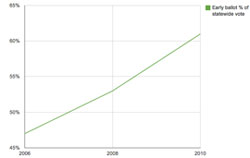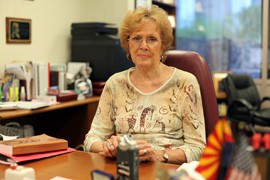Cronkite News has moved to a new home at cronkitenews.azpbs.org. Use this site to search archives from 2011 to May 2015. You can search the new site for current stories.
Experts: The real potential for fraud is in mail-in ballots
PHOENIX – With over 60 percent of Arizona voters expected to cast early ballots this year, state and county election officials say the public should be confident that the verification process is effective at preventing fraud.
“We want people to see the process, to know that there is very little room for error,” Maricopa County Recorder Helen Purcell said. “Very little room.”
According to data collected by News21, a national reporting project made up of 11 universities and hosted at Arizona State University, election fraud is rare nationwide and in Arizona but there is more alleged fraud in absentee ballots than any other type. The investigation found an infinitesimal amount of voter-impersonation fraud, the impetus for voter-ID laws around the country.
While voter-ID and proof-of-citizenship laws have partisans bickering, election experts say the real potential for fraud and mistakes happens with mail-in ballots, a potential they said has gone relatively unregulated.
“What little of fraud in voting there is does happen in absentee ballots,” said Zachary A. Smith, a regents’ professor at Northern Arizona University’s Department of Politics and International Affairs.
For many Arizonans, voting at the polls is a fading memory. “No reason, no witness” balloting, which means anyone can cast a mail-in ballot, started in Arizona in 1992. The percentage of Arizonans using early ballots has risen steadily over the past 10 years, Purcell said.
“In Arizona it is the election system, the precinct is no longer the election system,” said Stephen Ansolabehere, a political science professor at Harvard University’s School of Government and co-author of a new report from Caltech/MIT’s Voting Technology Project that looks at the growth of mail-in balloting.
Arizona’s share of the voting rights debate focuses on its proof-of-citizenship law, Proposition 200, passed in 2004, which requires voters using either a state or federal voter registration form to provide proof of citizenship. The 9th U.S. Circuit Court of Appeals ruled that the state couldn’t ask for proof of citizenship for a federal voter registration because it was preempted by a federal law. Arizona appealed the ruling and the case will head to the U.S. Supreme Court early next year.
There have been no laws passed or any proposed legislation recently seeking to change the process of counting early ballots in Arizona, according to Matt Roberts, a spokesman for the Arizona Secretary of State’s Office. He said the state is concerned about and will prosecute election fraud but added that there are many safeguards in place for early balloting.
“These ballots are secured,” he said. “Voters should have a great deal of confidence in the platform.”
Roberts noted that his office uses an interstate database that recently turned up nine new cases of people voting in both Arizona and another state during the 2008 presidential election. He said some of the illegitimate votes were cast using mail-in ballots.
Under Arizona law, election officials must compare signatures on early ballots to the signatures on voter registration forms. In addition, machines that tabulate early ballots are subjected to a logic and accuracy test by the Secretary of State’s Office to ensure they’re working properly, and tabulation centers are required to have webcams operating 24 hours a day to allow the public to see areas where ballots are counted.
“We are as secure as we can possibly be, short of having an armed guard,” Yavapai County Recorder Leslie Hoffman said.
Purcell said the checks in Arizona’s early ballot system are sufficient to deter people from attempting fraud.
“They know that’s going to happen so how are they going to get past that? They really can’t,” she said.
But Ansolabehere, the Harvard professor, said signature matching can be problematic.
“Relying just on signature matching is putting a lot of subjective judgments in the hands of the person who is doing the authentication,” he said.
He added that voters signatures can change because of age or name changes from divorce or marriage.
Purcell said every signature is matched electronically and verified by a someone who goes through training for early tabulation counts. Her office hires 100 extra people to have a total of 200 looking at signatures, she said.
“We can count anywhere from 50,000 to 100,000 ballots a day,” she said.
If a signature is questioned then a member of the regular staff trained in forensic writing looks at the ballot, Purcell said. She said that person will try to contact the voter, and most of the time it’s a harmless mistake, like a wife or husband accidentally putting his or her ballot in their spouse’s envelope or someone who has difficulty signing because of a broken arm.
The Caltech/MIT report, which analyzed mail-in voting among other aspects of elections, said potential consequences from the liberalization of absentee voting are coercion, fraud, security and accuracy.
“You lose administrative control, and it’s thought that that control is your best control against abuses,” Ansolabehere said.
Ansolabehere noted that with mail-in ballots there are no poll workers or administrators present when a voter casts his or her vote, which may leave the ballot open to potential mistakes or abuse.
He said examples of mail-in ballot fraud include rare instances of organizations coercing members to vote a certain way or someone selling absentee ballots.
Charles Stewart, a political scientist at the Massachusetts Institute of Technology and co-author of the Caltech/MIT report, said the shift to mail voting counters the improvements made after the Help America Vote Act, which improved the accuracy of voting equipment used at the polls.
“Whenever you send in a mail-in ballot you don’t have the sort of those fail-safe mechanisms,” he said.
Stewart said a good alternative for mail-in voting is allowing people to vote early at precincts. That option, which Arizona has, provides convenience and security and gives voters more time to weigh decisions, he said.
“If you’re looking for convenience, the best practice is to encourage people to vote in person and have them vote early,” Stewart said. “Then leave the mail-in option for voters who would not get to vote otherwise.”










